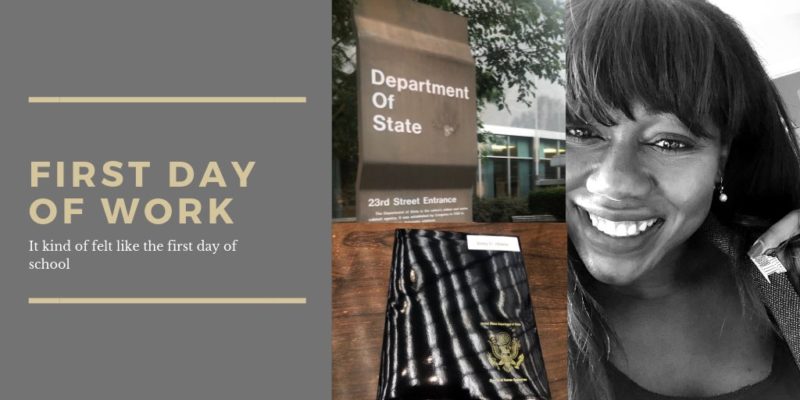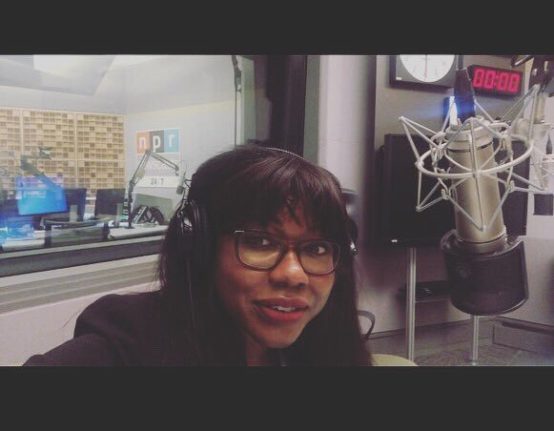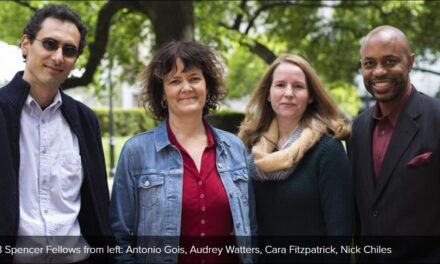Former WAMU education reporter Jenny Abamu explains how she came to leave a field she loves and the need to give beat reporters time to write memorable, meaningful stories.
By Kristen Doerer
Education reporter Jenny Abamu made a surprise announcement a couple of weeks ago: She was leaving the Washington, D.C.-area NPR affiliate WAMU to become a U.S. diplomat.
Raised in one of the poorest suburbs of Dallas, with front-row experience of what an inadequate education looks like, Abamu had been devoted to education. She pursued a master’s degree in international and comparative education at Columbia University’s Teachers College, where she saw a need for good education reporting.
“There was corruption in the pathway of the money going down to the people,” she said. “If the public had known, they could have held these people accountable.”
After a stint covering breaking news at NY1 in New York, she found her way to education reporting at Columbia’s EdLab, an online publication devoted to education issues. While there, however, Abamu began considering other career paths. “I was working part time in New York City,” she explained, “not the ideal situation for anyone.”
In 2017, she landed a full-time position covering edtech at EdSurge, but she continued to take a series of exams to become a foreign service officer. She waited for her security clearance. It never came. In the meantime, she became the education reporter at WAMU.
Almost immediately, she began producing thoughtful and investigative segments, particularly on special education issues. Still in her first year on the local beat, Abamu was one of education journalism’s rising stars. But she was also increasingly frustrated and exhausted by the work she was being asked to do.
Last month, Abamu’s security clearance came through.
In the following conversation, which has been edited for clarity and length, Abamu describes the frustrations of being a daily news reporter, her misgivings about the journalism industry today, as well as her belief that it can hold the powerful accountable and is key to bringing about change.
Sign up here for our free newsletter featuring the week’s best education news & newsroom comings and goings.

Abamu’s journalism for WAMU won enormous attention in a remarkably short period of time.
Kristen Doerer: Why leave now?
Jenny Abamu: WAMU is a wonderful place to be. But I knew if I stayed in journalism that I wanted to be an investigative reporter. WAMU currently doesn’t have such a role, so I might have had to leave to do it.
Also, I hate daily reporting. I like to take my time on stories. WAMU is moving to more of a daily model; for them, that’s about being relevant to the daily audience. That’s what they want.
I have really fundamental ideas about the way my work should be, and that does not always jive with the daily queue that needs to be filled. I try to protect my byline. I tell all reporters to protect their bylines. Because at the end of the day, it’s your name on the paper. To do the kind of reporting I wanted, I had to take work home and work on the weekends. What I was doing was not sustainable.
KD: Is there a brain drain around education journalism? Why?
JA: I don’t know if this is true. But I have some ideas about why education reporters might be tempted to leave their jobs.
It’s not the sexiest topic. If you’re a reporter, if you want to be famous really fast, go cover the White House. Political reporters get the most airtime.
I have heard people call education an entry beat. People have no idea how complicated this is. I cover six districts — to learn the system is crazy. I had to learn three different sets of state regulations and six different district regulations. You need people who have the expertise to do this job well.
To do the kind of reporting I wanted, I had to take work home and work on the weekends. What I was doing was not sustainable. – Jenny Abamu
KD: One of your signature stories at WAMU was about how schools in Fairfax County failed to report their use of seclusion and restraint on students, many of whom have special needs and some of whom were as young as 6 years old. How did you find the story?
JA: In Virginia, there’s a season when the state Legislature opens up a bunch of policy proposals. One of the proposals had to do with using seclusion and restraint in schools. And I actually hadn’t really heard of it. It just kept nagging at me. So I looked on the Office for Civil Rights website, where you can get federal student civil rights data from schools, to see how often schools are reporting that they use this. Fairfax County had zero, D.C. had about 14, Loudon County had something in the teens, too, low numbers, and then Montgomery County in Maryland had more than 1,400. I was shocked when I saw that. I sent them an email asking if this number was correct because I really thought it was an error.
I met with the district officials, and they were explaining what seclusion and restraint was, and they demonstrated [the procedure] to me, how they documented it, how they had revamped their whole system to do more documentation with fidelity. And it had me thinking, Fairfax is a comparable size district to Montgomery County, even larger, and they had zero for the last 10 years. Even if they held a kid against their will in any kind of way, they’re supposed to write it down. You haven’t held a kid once in 10 years? Never?
KD: Once you had that suspicion, what did you do?
JA: Because I knew this happened mostly to students with disabilities, I reached out to a few special education advocates to see if they had ever heard of it. My phone started to flood with phone calls from so many families. I think they posted my phone number in some kind of group for people who had dealt with it. I haven’t seen that many parents cry before in my entire life.
It took months for [school officials] to let me see one of the seclusion rooms. I tried to keep my face straight, but I was terrified of the space that elementary children were being put into.
KD: How did you get around those barriers to access? How did you see the seclusion room?
JA: I’m at the school board meetings. I’m always there. They had to know that I’m not going away. I live here. I’m a local reporter. I’m not a national reporter. I’m not parachuting in from New York City. You can try to ignore me for as long as you want, but eventually, you’re going to see me.
I’m a local reporter. I’m not a national reporter. I’m not parachuting in from New York City. You can try to ignore me for as long as you want, but eventually, you’re going to see me. – Jenny Abamu
KD: WAMU was your first foray into radio. What’s different about reporting for radio?
JA: I love radio. There’s something about hearing someone’s voice that takes me to a place I can’t get on paper. Sometimes in radio we leave in a pause. We only have so much airtime, but we want to leave the pause in between someone’s sentences because the pause says so much. You can’t get a pause in print, or a chuckle. What does that chuckle mean? Is it an inappropriate chuckle? Is it an appropriate chuckle? That tells you so much about the people in the story, about the emotions they’re going through.
When I was doing that story on seclusion and restraint, you’ll hear the boy playing the recorder in the background. There is something about bringing the scene to life, where the mother is talking, she is crying, and her son is sitting there playing the recorder, and it’s just like you’re in her living room.
KD: On which stories could education reporters do better?
JA: People have done really great work on the segregation story, but I think it’s more complex. And I think education reporters—myself included—could benefit from doing more intersectional stories. If you’re talking about segregation, you should also be talking about housing. We need to start thinking like that to be able to do work on the next level. Sometimes we try to keep education in its own little bubble when really it is a microcosm of things.
I hate when people say Black and Latino students are doing poorly in school without context. That line is in a lot of stories without context. When you perpetuate the narrative that Black and Latino kids are constantly failing, without context, what audience does that serve? What does that do for the public?
Don’t just do stuff, do news. The internet doesn’t need more stuff. There’s enough stuff… We need news — news that people remember. – Jenny Abamu
KD: How does journalism need to address those blind spots? Is part of the problem that we need more reporters of color who can see these stories from different lenses?
JA: Yes, it’s good to have reporters of color, but it’s also good to equip reporters with knowledge. Even reporters of color don’t innately know things.
One of the things I’ve been trying to do is: How do I tap into my own experiences to tell better stories? It’s not innate to do that. Being a person of color, or someone coming for a poorer, disadvantaged background, are you able to tap into your own experience to tell stories, find leads? How are those things tied to policy?
I grew up in one of the poorest suburbs in Dallas. Our education system sucked. Now that I cover education, I know how bad my teachers were. Where we grew up, I never met a journalist. I really wonder how it would have changed my education experience.
If you look at the Dallas Morning News, they don’t have a lot of diversity in their staff. I know they’re trying. But that shows. You don’t know where to start looking if you don’t come from those areas.
To learn more about how the media covers education, follow The Grade on Twitter and Facebook.

Abamu posted this image earlier this week, as she started her new job at the State Department.
KD: What do you say to education reporters who are nervous about going into different spaces like special education?
JA: It’s our obligation as reporters to tell stories for people who can’t tell their own story. And it’s our obligation to do the work, to learn about different populations to tell their stories. I took a class at [the Education Writers Association] on the LGBTQ community because I wanted to make sure I wasn’t avoiding those stories, and that when I did those stories I would tell them well because I don’t know that community, I’m not part of that community, and I have to learn.
KD: What insights do you have now that you’re leaving the business?
JA: I’m afraid for journalism sometimes, to be honest. Don’t just do stuff, do news. The internet doesn’t need more stuff. There’s enough stuff. We don’t need more “content,” we need news — news that people remember.
I think people are looking for information that they can trust. That’s why outlets like ProPublica, places investing in investigative and in-depth reporting, those places stand out to me. Those places that invest in copy editors. If you want to do journalism, you’re supposed to hold the powerful accountable so the stakeholders in our society can have a functioning society. Quality will drive page views. You don’t need me, the journalist, to do the same thing that a blogger can do.
Every time that someone is doing a story that doesn’t matter, there are stories that do matter that don’t get done.
RELATED POSTS
A brain drain in education journalism
Reflections from 8 years covering New York City schools (Ben Chapman)
Breaking free from the hamster wheel of daily news coverage (WBEZ Chicago)
‘I used to be an education reporter.’ (Dorie Turner Nolt)
Writing better stories about students with disabilities (Amy Silverman)
How the Washington Post missed the DC schools graduation rate scandal so badly, for so long














